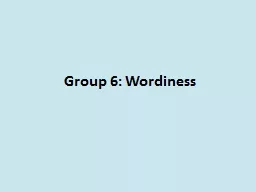/


Wordiness The use of unnecessary words Readers want to read technical documents as quickly as possible so eliminate any words not absolutely necessary to convey your meaning and purpose Wordiness ID: 444948
Download Presentation The PPT/PDF document "Group 6: Wordiness" is the property of its rightful owner. Permission is granted to download and print the materials on this web site for personal, non-commercial use only, and to display it on your personal computer provided you do not modify the materials and that you retain all copyright notices contained in the materials. By downloading content from our website, you accept the terms of this agreement.
Slide1
Group 6: WordinessSlide2
Wordiness
The use of unnecessary words.
Readers want to read technical documents as quickly as possible, so eliminate any words not absolutely necessary to convey your meaning and purpose.Slide3
Wordiness
Y
ou may not notice the wordy phrases that appear in your writing because you have used them for a long time or have read them in many documents.
You may have to make a special effort to spot these phrases and replace them with more concise, effective words.
You can also eliminate some wordy phrases instead of replacing them in many documents. Slide4
Wordiness
Examples:
Despite the fact that you have the opportunity to do your homework, it is improbable that you will.
Despite the fact that
you
have the opportunity to
do your homework, it is
improbable
that you will.
Although
you
can
do your homework, it is
not likely
that you will.Slide5
Wordiness
Examples:
As a matter of fact, it is imperative that we pass this class in order to be
successful.
As a matter of fact, it is imperative that
we pass this class
in order
to be successful.
We
need to
pass this class to be successful.Slide6
Wordiness
Examples:
A limited number of students studied in accordance with the teacher’s request.
A limited number of
students studied
in accordance with the teacher’s request.
A few
students studied
as the teacher requested.Slide7
IT IS TIME TO PLAY……..Slide8Slide9
Alternatives to saying…..
“Optimum”
1. Best
2. MostSlide10
Alternatives to saying…..
“In this day and age”
1. Today
2. NowSlide11
Alternatives to saying…..
“Commence”
1. Begin
2. StartSlide12
Alternatives to saying…..
“At this point in time”
1. Now
2. CurrentlySlide13
Alternatives
to saying
…..
“Ascertain”
1. Learn
2. Find outSlide14
Alternatives to saying…..
“It is crucial that”
1. Must
2. ShouldSlide15
Alternatives to saying…..
“Subsequent to”
1. After
2. NextSlide16
Alternatives to saying…..
“Indebtedness”
1. DebtSlide17
Group 6: Eggs & Salmonella
Before:
Although
the average egg looks innocent enough, it can harbor dangerous food borne bacteria. Salmonella
enteritidis
is the bacteria that can invade eggs in several ways. It is not passed hen to hen but usually from rodent droppings to chickens. Egg shells can be contaminated by fecal matter. It comes from the intestines and feces of infected animals including chickens. It can be passed to the egg shell when the chickens sit on the eggs. Salmonellosis (an infection caused by salmonella bacteria) can also be passed to eggs when the ovaries of chickens silently harbor the salmonella bacteria. Then, the eggs are contaminated while inside the chicken, before the shells are even formed. Because of the recent alarm about egg recalls, the public has learned that USDA inspectors don’t check hen houses or look into farms’ salmonella prevention programs, such as inoculation. Recent inspections of egg farms have brought attention to the numerous rodent holes in the chicken farms. Rodent holes are a sign that mice have entered the buildings and infecting hens with salmonella. Eggs are washed and disinfected to deal with the dirt and germs on the shells. Many farmers inoculate the hens, but salmonella contamination in eggs is not prevented entirely by this method.
After
:
The
average egg can harbor dangerous food borne bacteria like salmonella. The public has learned that USDA inspectors don’t look into farms’ salmonella prevention programs like inoculation. Many farmers inoculate
hens
, but this method does not prevent salmonella contamination completely. Egg farm inspections have brought attention to rodent holes in the chicken farms. Rodent holes are a sign that hens may be infected with salmonella. The Salmonella
enteritidis
bacteria can invade eggs in several
ways
.
Methods of Salmonella contamination:
From rodent droppings to chickens.
The egg shells can be contaminated by fecal matter.
The infected chickens can produce the bacteria in the intestines and feces.
The bacteria can then be passed to the egg shell when the chickens sit on the eggs.
The eggs can become contaminated while inside the chicken before the shells is even formed.